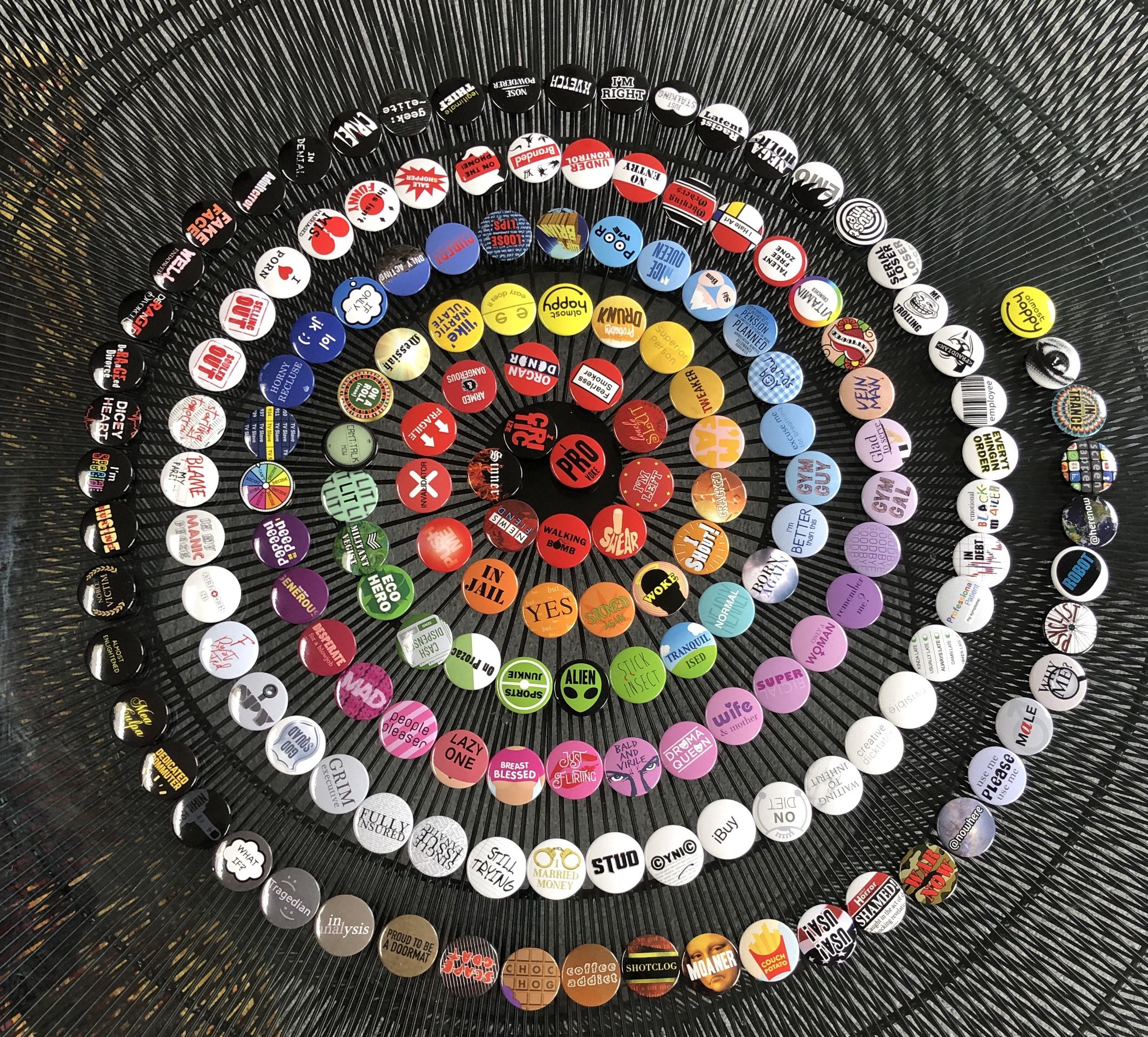Interview
Hephzibah Kaplan
Hephzibah Kaplan is a painter and textile artist. She has recently been specializing in button art. She trained in textile and print at Middlesex University, then went on to an MA in Art Therapy at University of Hertfordshire. She has also studied at the Camden Arts Centre and in artists' studios.
In addition to the individual buttons, developed with her husband, Brian Kaplan, she has recently been creating composite images using the button collection along with portraits. 'Dancing with our Selves' represents the interplay of many of our sub-personalities that are operating at an unconscious level. Although filled with humor, when taking a closer look at these works, the meaning tends to hit close to home, often leading the viewer to digest the message and go, “Yikes, this is me!”
Hephzibah aims for her art to have a visceral impact on the viewer, who is provoked to delve deeper into the concepts portrayed.
What is your background and how did you start your journey in the art world?
“I have always been a painter, since before I could walk. Being constantly involved with painting, drawing and creating, I have learned directly from artists and went on many art courses and trainings, in addition to the skills I acquired at university.
Since then I have continued with my painting, selling at small exhibitions and art fairs, and am very involved in the creative processes of others. In the last few years, I’ve been collaborating with my husband—an outsider artist and therapist—on a conceptual project, making visuals that aim to provoke people into thinking differently. We use reverse psychology and humor to depict many of the sub-selves or archetypes that may be negatively influencing people, and perhaps causing behavior that does not serve them well. By encapsulating these archetypes in a graphic form, and turning them into physical badges or buttons, our work is presented as 'Pushing Your Buttons with Reverse Psychology'.”
What does your work aim to say? Does it comment on any current social or political issues?
“Comedy and art have a long association. Just as art can bring people to a better place, so can comedy. In the Tate Museum’s podcast, The Art of Comedy, Charlie George states the origins of comedy as an art form can be traced all the way back to ancient Greece. Humor and irony were consistently used by comic poets and playwrights to influence political opinions. There is a picture by Hogarth called Caricatures and Characters. Many others, including DaVinci, DuChamp, Magritte, Lichtenstein, Richard Hamilton, Grayson Perry et al all use humor in their work to comment on social and political issues.
Our work offers perspectives on the internal world of personal issues, which of course are influenced by social and political contexts. My husband and I have spent 20 years creating these buttons which emerged out of our coaching to help people laugh at their sub-selves, or parts of themselves, have creative epiphanies, and get way happier. When people are amused by what they see, we link this to the potential for increased happiness and improved relationships with self and others. So, yes, the work comments on and provokes social and political issues.
We have created 175 buttons, 114 of which appear in our recently published book, Almost Happy: Pushing Your Buttons with Reverse Psychology.”
“Since we started to show the button collection, we have noticed the visual impact on the viewer. Some people smile, some laugh, some go into shock as they recognize themselves or their friends and family abstracted into a button. This offers an opportunity for a wake-up call; a new awareness leading to personal change and reform.”
Which current art world trends are you following?
“My husband and I are very interested in conceptual and political art. From Banksy to Koons, to the interface of comedy and art, we enjoy the subliminal and the impactful. Any art that makes us laugh or makes us wake up and think ‘yes!’ is of interest.”
Do you plan your work in advance, or is it improvisation?
“The buttons were developed over many years. Marshall McLuhan’s phrase, ‘the medium is the message’, informed our graphic approach. But the conceptual thinking and honing of the archetypes emerged from real experience working with clients and patients. We like wordplay and Scrabble, and the word pairings of our monikers were scrutinized till we felt they described the aspect of the sub-selves we were characterizing in a fun, and sometimes shocking way.”
What process, materials, techniques, etc., do you use to create your artwork?
“Lots of thought and reflection goes into every button. To get the work done, we use Photoshop, photography, collage, and a badge press.”
What does your art mean to you?
“My work offers opportunities to catalyze change in people in a positive direction. This is meaningful. When someone remains on their diet, gives up smoking, regulates another addiction, considers managing their controlling behavior better, is less self-centered, or becomes more assertive as a result of seeing these buttons, we are delighted. They are all making small and large steps for social and personal change.”


What is your favorite artwork and why?
“Our absolute favorite piece is Jeff Koon’s Puppy, which is outside the museum of Bilbao. It is joyful, funny, and clever. Growing flowers are animated into a relational being that the viewer wants to stroke. The scale of the piece is formidable but not overpowering. The colors, textures and form invite the viewer to play and engage. The emanating fragrances are not what we expect from a doggy smell, and it makes the whole piece sweet. Watching viewers approach the puppy from afar is a delight as people just cannot stop smiling.”
Have you had any noteworthy exhibitions you'd like to share?
“We haven’t exhibited the button art and collages as yet, although they are visible in our book and on our website.”


Website: www.almosthappy.com
Instagram: @hephzibahkaplan










